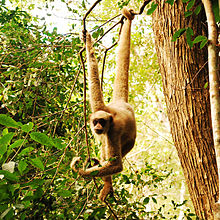genus of mammals From Wikipedia, the free encyclopedia
The muriquis, or woolly spider monkeys, are the genus Brachyteles.[1] There are two species, the southern (B. arachnoides) and northern muriqui (B. hypoxanthus) muriquis. The name "muriqui" comes from a native Tupi word meaning 'largest monkey'.
| Muriquis[1] | |
|---|---|
 | |
| Northern muriqui, Brachyteles hypoxanthus | |
| Scientific classification | |
| Domain: | Eukaryota |
| Kingdom: | Animalia |
| Phylum: | Chordata |
| Class: | Mammalia |
| Order: | Primates |
| Suborder: | Haplorhini |
| Infraorder: | Simiiformes |
| Family: | Atelidae |
| Subfamily: | Atelinae |
| Genus: | Brachyteles Spix, 1823 |
| Type species | |
| Brachyteles arachnoides É. Geoffroy, 1806 | |
| Species | |
|
Brachyteles arachnoides | |
They are the two largest New World monkeys. The northern muriqui is one of the most endangered monkeys in the world.[2] They are seen only in some forests in Brazil.
The adult muriqui is 15-23 inches (38–58 cm) long and weighs from 10-20 pounds (4.5-9 kilos) They are colored from brown to black and the bottom of their tails have no fur near the end.
Muriquis live in groups from four to 43. They do not fight about their territory. They mostly eat leaves. They sometimes eat fruit and flowers in the rainy season, as well as bark, bamboo, ferns, nectar, pollen, and seeds.
Seamless Wikipedia browsing. On steroids.
Every time you click a link to Wikipedia, Wiktionary or Wikiquote in your browser's search results, it will show the modern Wikiwand interface.
Wikiwand extension is a five stars, simple, with minimum permission required to keep your browsing private, safe and transparent.